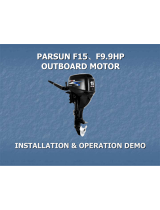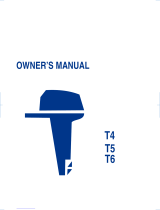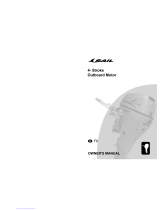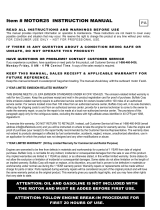Page is loading ...

OUTBOARD MOTOR
OWNER’S MANUAL
F2.6BM
SUZHOU PARSUN POWER MACHINE CO., LTD.

Thank you for owning a PARSUN outboard motor.
Thank you for your trust in our company and products.
“PARSUN” outboard motors are powerful, economic and safe with advanced technology
and processing technique.
Please read this manual carefully before operating your outboard motor. A through
understanding of the manual will help you to know this product for proper operation,
maintenance and care. This will ensure that your outboard motor is operated well under
various conditions.
“PARSUN” seeks continuous improvement in product quality. Therefore, while this manual
contains the most current product information available at the time of printing, there may
be minor discrepancies between your machine and this manual. If there is any question
concerning the manual, please consult your local PARSUN dealer.
Data, illustrations or explanations in this Owner’s Manual do not constitute base for any
legal claim against our company.
SUZHOU PARSUN POWER MACHINE CO., LTD

Engine Identification Numbers
Outboard motor serial number
The outboard motor serial number is marked on the label. The label can be found on the bracket left
assembly or on the upper part of the bracket swivel.
Record your outboard motor serial number in the spaces provided to assist you in ordering spare parts
from your Parsun dealer, or for reference in case your outboard motor is stolen.
1. Outboard motor serial number location
Serial number as follows:
Engine serial number
The engine serial number is carved on the aluminum casting of engine.
Serial number as follows:
SN
1

Manufacturer’s Declaration
This outboard motor complies with the requirements of Directive 2003/44/EC in relation to the exhaust
and noise emissions. The following installation and maintenance instructions, if applied, guarantee that the
outboard motor will remain in compliance with:
1. Exhaust emissions limits throughout the normal life or the engine (350 hours or 10 years, whichever
occurs first) and under normal conditions of use.
2. Noise emissions limits under normal conditions of use.
High Altitude Warning
Operation at High Altitude
The density of air at high altitude is lower than at sea level. Engine power is reduced as the air mass and
air fuel ratio decrease. Outboard motor output will be reduced. This is a natural trend and cannot be
changed by adjusting the engine. At sufficiently high altitudes increased exhaust emissions can also result
due to the increased enrichment of the air fuel ratio. Other high altitude issues can include hard starting,
increased fuel consumption and spark plug fouling.
To alleviate high altitude issues other than the natural power loss, dealer can provide a high altitude
carburetor main jet. The alternative main jet and installation instructions can be obtained by contacting
Customer Support.

The part number and recommended minimum altitude for the application of the high altitude carburetor
main jet are listed in the table below.
MODEL MAIN JET PART NUMBER ALTITUDE
F2.6 Standard Main Jet H100-S 2000 Feet (609.6 Meters)
Altitude Main Jet H100×1.08
Operating the engine with the wrong engine configuration at a given altitude may increase its
emissions and decrease fuel efficiency and performance. When the carburetor has been modified
for high altitude operation, the air-fuel mixture will be too lean for low altitude use. Operation at
altitudes below 609.6 meters (2,000 feet) with a modified carburetor may cause the engine to
overheat and result in serious engine damage. For use at low altitudes, have your dealer return the
carburetor to original factory specifications.
WARNING

Table of contents
1. Main components and General information……………………..……..…………….………….…1
1.1. Main components……………………………..…….………….………………………….…..……1
1.2. General information………………………………………………………….…………………..….3
1.2.1. Specifications…………………………………………………….…………….……………….…3
1.2.2. Fueling instructions…….………………………………….…………..……………….……..…..4
1.2.3. Propeller selection…….……………………………………………….…………………......…...5
2. Operation…………….……….…………………………………………….………............................6
2.1 Installation………………………………………………………………….……………..................6
2.1.1. Mounting height………………………………………………………….…………….................7
2.1.2. Clamping the outboard motor………………………..…………….….………….……..............9
2.2 Breaking in engine……………………………………………………….…......…….....................9
2.3 Pre-operation checks………………………………………………….…………….....................10
2.4 Filling fuel……………………….………………………………………………............................12
2.5 Starting engine……..…………………………………………………….……….........................13
2.6 Warming up engine.…………………………………………………….……….........…..............16
2.7 Shifting.…………………………………………………….…………….………................….......18
2.7.1. Forward………………………………………………….…………….………...........................18
2.7.2. Reverse………………………………………………….…………….………........... ..........….19
2.8 Tiller………………………………………………………………………………………................20
2.9 Stopping engine………………..……………………………………………………. .…..........….22

2.10 Trimming outboard motor………………………………………………………………..........…23
2.11 Tilting up and down………………………………………………………………….........……...24
2.11.1. Tilting up………………………………………………………………………………..........….24
2.11.2. Tilting down………………..……………………………………………………..….................26
2.12 Cruising in other conditions…………………………………………………………..........……27
2.12.1. Cruising in shallow water…………………………………………………………......…....….27
2.12.2. Cruising in salt water………………………………………………………………..........……28
3. Maintenance………………………………………………………………………………..............29
3.1 Greasing………………………………………………………………………………..............…29
3.2 Cleaning and adjusting spark plug……………………………………………….....…….....…30
3.3 Checking fuel system………………………………………………………………….........…...30
3.4 Inspecting idling speed……………………………………………………………….........….…31
3.5 Changing engine oil…………………………………………………………………........…..….31
3.6 Checking wiring and connectors…………………………………………………….....….....…33
3.7 Checking for leakage…………………………………………………………………...........…..33
3.8 Checking propeller……………………………………………………………………….........…34
3.8.1. Removing the propeller…………………………………………………………….......…...…35
3.8.2. Installing the propeller……………………………………………………………….........…...35
3.9 Changing gear oil…………………………………………………………………….......…...….36
3.10 Cleaning fuel tank………….……………………………………………..…..................……...37
3.11 Checking and replacing anode(s).………………………………………...................….........38

3.12 Checking top cowling………….……………………………………………....................….....38
3.13 Maintenance table………….……………………………………………….................…….....39
4. Transporting and storing outboard motor……..…………………..……….…..................…... .41
4.1 Transporting…………………………………………………………………...................….......41
4.2 Storing…………………………………………………………….……….................………... ..42
5. Action in emergency………………………………………....……............................................44
5.1 Impact damage………………………………………………………………............................44
5.2 Starter will not operate…………………………………….....................................................44
5.3 Treatment of submerged motor…………………………….…………………........................48
6. Troubleshooting………………………………………………….……………….........................50
7. Circuit diagram ………………………………………………….…………….............................54

1. Main components and General information
1.1 Main components
1
1.Top cowling 8.Clamp bracket 14.Throttle grip
2.Carrying handle
9.Tiller handle 15.Clamp screw
3.Steering friction screw 10.Engine stop button/ 16.Rope attachment
4.Anti-cavitation plate Engine stop lanyard switch 17.Gear shift lever
5.Propeller 11.Starter handle 18.Choke knob
6.Cooling water inlet 12.Top cowling lock levers
7.Trim rod 13.Throttle friction adjuster
16
11
13
12
14
15
17
18
10
2
1
5
4
3
6
8
7
9

Your model includes a built-in fuel tank, its parts are as follows:
1. Air vent screw 3. Built-in fuel tank
2. Fuel tank cap 4. Fuel cock (close position)
WARNING
The fuel tank supplied with this engine could only be used as supply of fuel for its running and
must not be as a fuel storage container.
2
1
2
3
4

1.2 General information
1.2.1 Specifications
Parameter
Items
Data
Items
Data
Type of engine
4-stroke S
Recommended fuel
Unleaded regular gasoline
Displacement
72cm3
Built-in fuel tank capacity
1.2L
Bore X stroke
54.0mm×31.5mm
Recommended engine oil
SAE10W30 or SAE10W40
Gear ratio
2.08
(
27/13
)
Engine oil quantity
0.35L
Overall length
645mm
Recommended gear oil
Hypoid gear oil SAE
﹟
90
Overall width
343mm
Gear oil quantity
75cm3
Overall height(S/L)
1013/1140mm
Spark plug
BR6HS
Weight(S/L)
17/18Kg
Spark plug gap
0.6
~
0.7mm
Transom height(S/L)
381/508mm
Performance
Items
Data
Items
Data
Maximum output 1.9Kw/5500Rpm
(2.6HP)
Valve clearance IN
(cold engine)
0.08~0.12mm
Full throttle
operating range
5250~5750Rpm Valve clearance EX
(cold engine)
0.08~0.12mm
Idling speed
(in neutral) 1900±100Rpm Tightening
Torque for
engine
Spark plug 25.0Nm
Engine oil
drain bolt
18.0Nm
3

1.2.2 Fueling instructions
Fueling instructions:
Recommended gasoline:
Regular unleaded gasoline, If it is not available,
then premium gasoline.
If knocking or pinging occurs, use a different brand of gasoline or premium unleaded fuel. If leaded
gasoline is usually used, engine valves and related parts should be inspected after every 100 hours of
operation.
WARNING:
Do not smoke when refueling, and keep away from sparks, flames, or other sources of ignition.
Stop engine before refueling.
Refuel in a well-ventilated area. Refuel portable fuel tanks off the boat.
Do not overfill the fuel tank.
Take care not to spill gasoline, if gasoline spills, wipe it up immediately.
Tighten the filler cap securely after refueling.
If you should swallow some gasoline, inhale a lot of gasoline vapor, or get gasoline in your eye,
get immediate medical attentions.
If any gasoline spills onto your skin, immediately wash with soap and water. Change clothing if
gasoline spills on it.
Touch the fuel nozzle to metal components to prevent electrostatic sparks.
4

CAUTION:
Use only new clean gasoline which has been stored in clean containers and is not contaminated
with water or foreign matter.
Engine oil:
Recommended engine oil: 4-
stroke outboard motor oil SAE10W30 and SAE10W40 (0.35L).
WARNING:
Do not start the engine when the oil level is low. Serious damage might occur.
Always check the oil level before starting the engine.
CAUTION:
All 4-stroke engines are shipped from the factory without engine oil.
1.2.3 Propeller selection
The performance of your outboard motor will be critically affected by your choice of propeller, as an
incorrect choice could adversely affect performance. The outboard motor is fitted with propellers chosen
to perform well over a range of applications, but there may beuses where a propeller with a different pitch
would be more appropriate. “PARSUN” dealers stock a range of propellers and can advise you and install
a propeller on your outboard that is best suited to your application.
For a greater boat load and a low engine speed, a smaller-pitch propeller is more suitable. Conversely,
A large-pitch propeller is more suitable for a smaller operating load as it enables the correct engine speed to
be maintained.
5

2 Operation
2.1 Installation
Mount the outboard motor on the center line (keel line) of the boat. For boats without a keel or which are
asymmetrical, consult your dealer.
1
1. center line (keel line)
NOTE:
During water testing check the buoyancy of the boat, at rest, with its maximum load. Check that
the static water level on the exhaust housing is low enough to prevent water entry into the power head,
when water rises due to waves when the outboard is not running.
WARNING:
Overpowering a boat could cause severe instability. Do not install an outboard motor with more
horsepower than the maximum rating on the capacity plate of the boat. If the boat does not
have a capacity plate, consult the boat manufacturer.
6

Improper mounting of the outboard motor could result in hazardous conditions. For permanently
mounted models, your dealer or other person experienced in proper rigging should mount the
motor. If you are mounting the motor yourself, you should be trained by an experienced person.
For portable models, your dealer or other person experienced in proper outboard motor mounting
should show you how to mount your motor.
The information presented in this section is intended as reference only. Proper mounting depends
in part on experience and the specific boat and motor combination.
2.1.1 Mounting height
The mounting height of the outboard motor greatly affects your boat running efficiency. If the mounting
height is too high, cavitation tends to occur, thus reducing the propulsion. If the mounting height is too low,
the water resistance will increase and thereby reduce engine efficiency. Mount the outboard motor so that
the anti-cavitation plate is between the bottom of the boat and a level 25mm below it.
7
~

NOTE:
The optimum mounting height of the outboard motor is affected by the boat and motor combination
and the desired use. Test runs at a different height can help determine the optimum mounting height.
For further information, consult your “PARSUN” dealer or boat manufacturer.
2.1.2 Clamping the outboard motor
1. Tighten the transom clamp screw evenly and securely. Occasionally check the clamp screws for
tightness during operation of the outboard motor because they could become loose due to engine
vibration.
WARNING:
Loose clamp screws could allow the outboard motor to fall off or move on the transom.
This could cause loss of control.
Make sure the clamp screws are tightened securely. Occasionally check the screws for
tightness during operation.
8

2. If the engine restraint cable attachment is equipped on your engine, an engine restraint cable or chain
should be used. Attach to a secure mounting point on the boat to avoid the engine being completely
lost if it accidentally falls off the transom.
3. Secure the clamp bracket to the transom using the appropriate bolts. For details, consult your PARSUN
dealer.
WARNING:
Avoid using bolts, nuts or washers inappropriate. After tightening, test running the engine and
check their tightness.
2.2 Breaking in engine
Your new engine requires a period of break-in to allow mating surfaces of moving parts to wear in evenly.
CAUTION:
Failure to follow the break-in procedure could result in reduced engine life or even severe engine
damage.
1. For the first hour of operation:
Run the engine at 2000 r/min or at approximately half throttle.
9

2. For the second hour of operation:
Run the engine at 3000 r/min or at approximately three-quarter throttle.
3. For the next eight hours of operation:
Avoid continuous operation at full throttle for more than five minutes at a time.
4. Operate the engine normally.
2.3 Pre-operation checks
Fuel
Check to be sure you have plenty of fuel for your trip.
Make sure there are no fuel leaks or gasoline fumes.
Check fuel line connections to be sure they are tight.
Be sure the fuel tank is positioned on a secure, flat surface, and that the fuel line is
not twisted or flattened, or likely to contact sharp objects.
Controls
Check throttle, shift and steering for proper operation before starting the engine.
The controls should work smoothly, without binding or unusual free play.
Look for loose or damaged connections.
Check operation of the starter and stop switches when the outboard motor is in the water.
Engine
Check the engine and engine mounting.
Look for loose or damaged fasteners.
Check the propeller for damage.
10

Checking the engine oil level
1. Put the outboard motor in an upright position (not tilted).
2. Check the oil level using the oil level check window to be sure the level falls between the upper and
lower marks. Fill with oil if it is below the lower mark, or drain to the specified level if it is above the
upper mark.
1.oil level check window
11
1

1. Upper level mark
2. Lower level mark
WARNING:
If any item in the pre-operation check is not working properly, have it inspected and repaired before
operating the outboard motor. Otherwise an accident could occur.
CAUTION:
Do not start the engine out of water. Overheating and serious engine damage can occur.
2.4 Filling fuel
WARNING
:
Gasoline and its vapors are highly flammable and explosive. Keep away from sparks, cigarettes,
flames, or other sources of ignition.
1. Remove the fuel tank cap.
2. Carefully fill the fuel tank.
12
/



